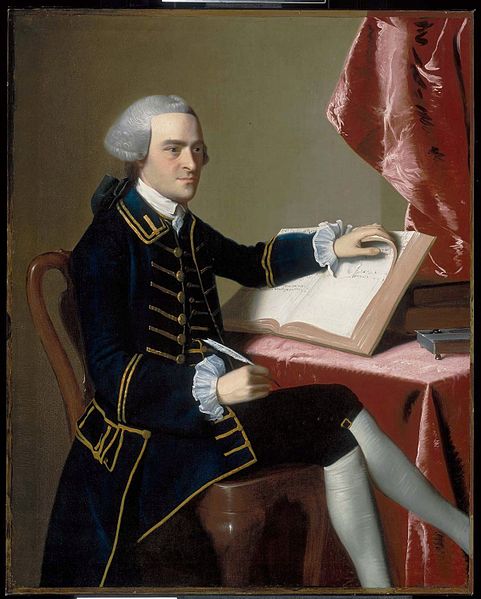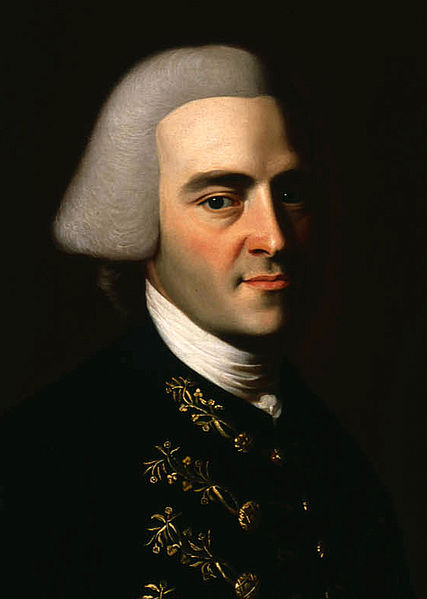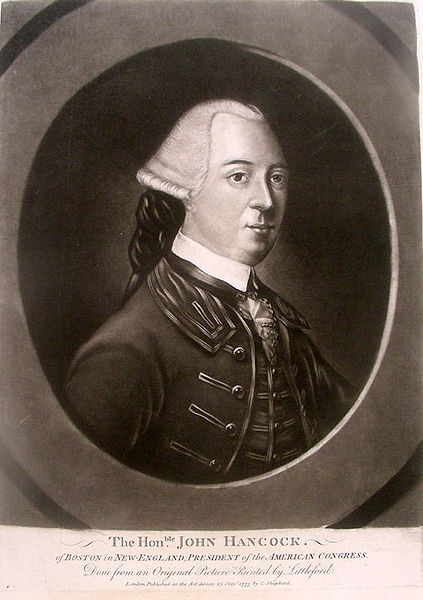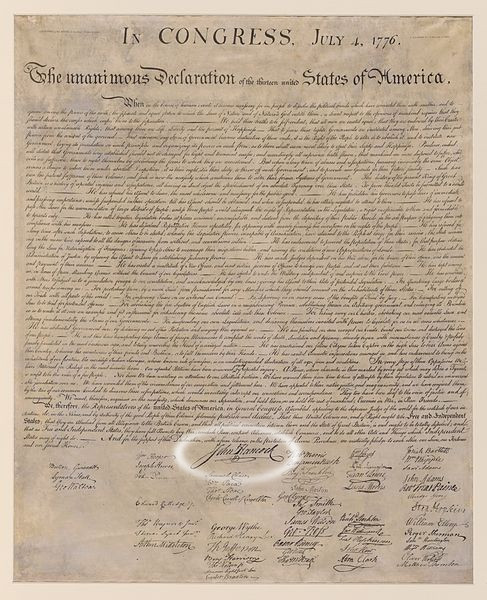Signer of the Declaration of Independence, President of the second Continental Congress, lawyer, husband, patriot: John Hancock was all of these and more.
Early Life & Education
John Hancock was born January 23, 1737 in Braintree Massachusetts. When he was a boy, he became friends with young John Adams, who had been baptized by Hancock’s father in 1734.

Portrait by John Singleton Copley
Public domain image.
Hancock’s family lived comfortably, but only owned one slave to help around the house. John was sent to live with his aunt and uncle after the death of his father in 1744.
Hancock graduated from Boston Latin school in 1750, then enrolled in Harvard College. In 1754, he received his bachelor’s degree. Just as the French and Indian War was beginning, he started working for his uncle at his uncle’s proprietor firm. His uncle’s firm was thriving during the war, so work was good. During his time of work at the firm, he was training for partnership.
From 1760-1761, Hancock lived in England developing relationships with clients and suppliers. When he returned, his uncle’s health had begun to fail him, so John took full partnership in the firm. In 1762, he became a member of Masonic Lodge of St. Andrews, instantly making him many influential connections. When his uncle passed away the following year, Hancock inherited the full firm thus making him one of the wealthiest men in the colonies. As well as the firm, he inherited the Hancock Manor, several thousand acres of land, and a few slaves. The slaves continued to work for John and his aunt, although they were freed upon the death of his uncle due to his uncle’s will. John never bought or sold any slaves.
Political Activism

John Hancock
This portrait belongs to the Massachusetts Historical Society.
Public domain image.
As tension grew between Britain and the colonies after the seven years war, Hancock was not yet a political activist, but disliked the taxes, not because of his personal rights, but because he believed it bad for the American economy. However, just as the tension with Britain reached its peak, John Hancock emerged as a leading activist.
In 1765 he was elected one of Boston’s select men, which was the post his uncle had previously held. Right after the Stamp Act was passed, he temporarily became a loyalist. Even though he thought Parliament was out of line, he wished the colonists would submit to their king. However, shortly after he changed his mind on the matter, but still disapproved of the violence.
In May 1766, Hancock was elected Massachusetts house of Representatives. Hancock’s political popularity benefitted greatly from the support of Samuel Adams, who had a lot of popularity with the citizens. Hancock and Adams were an unlikely pairing and had almost nothing in common, however they were good friends none the less and both were members of the Sons of Liberty.
Sons of Liberty
John Hancock and Samuel Adams’ role in the Sons of Liberty was dramatized by the History Channel in 2015. While the details and accuracy have been skewed in favor of storytelling, the show is entertaining and gives an general idea of the Sons of Liberty and their role in the beginning of the Revolutionary War, the Boston Tea Party, etc.
You can watch the episodes here, though keep in mind that they are rated TV-14 for violence and sexuality.
War Breaks Out; Hancock Attends Congress

Mezzotint engraving of Hancock, first published in England in 1775. Author Attributed to R. Purcell, working under the pseudonym C. Corbutt.
In 1767, the British imposed the Townshend Acts, and soon after in 1768 arrived the Boston Massacre followed by the Boston Tea Party, which Samuel Adams had a hand in starting. It was only a few short years after when the tension had reached its climax and the Revolution had begun. In 1774, Hancock was elected as president of the provincial congress, and was an important member of the committee of safety.
During his time there, he helped institute the idea for the first minutemen: militia that were on hand and ready to go into battle at a minute’s notice.
In December, the Provincial Congress elected Hancock as a delegate for the Second Continental Congress. Before he had reported for his duty to the Second Continental Congress, the Provincial Congress re-elected him their president. Having a foot in the door in both places gave him massive influence. So much influence, in fact, that the British officials considered arresting him in 1775, however they did not have enough reason to make a proper arrest.
August 1, 1775, after Congress recessed, Hancock married his fianceé Dorothy Quincy. The couple had two children that did not survive to adulthood.
Later that year, after Peyton Randolph resigned due to health issues, Hancock was elected president of the Continental Congress. On the fourth of July in 1776, John Hancock was the first and signer of the Declaration of Independence. Hancock’s signature is the largest signature of the Declaration as well; this is because when he signed it he said he did not want the King to have to put on his spectacles to read it.
In October of 1777, Hancock requested to return home to Massachusetts after more than two years of serving at the Continental Congress. When he returned to Boston he was reelected to the House of Representatives. After that, he served in various political roles until he died on October 8, 1793.

You can see that John Hancock’s signature (highlighted)
is clearly visible, large, and perfectly legible.


